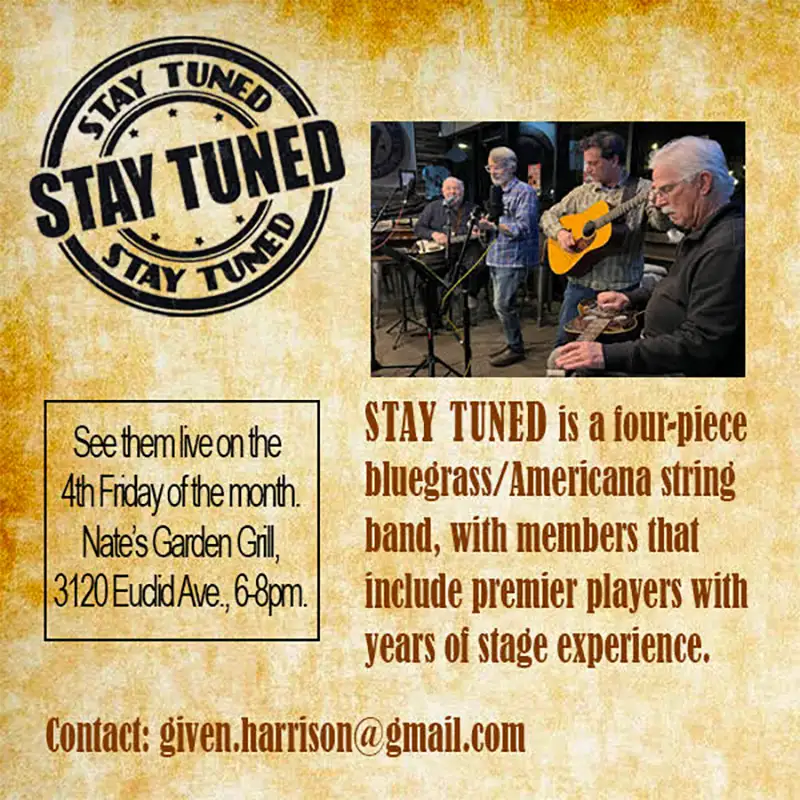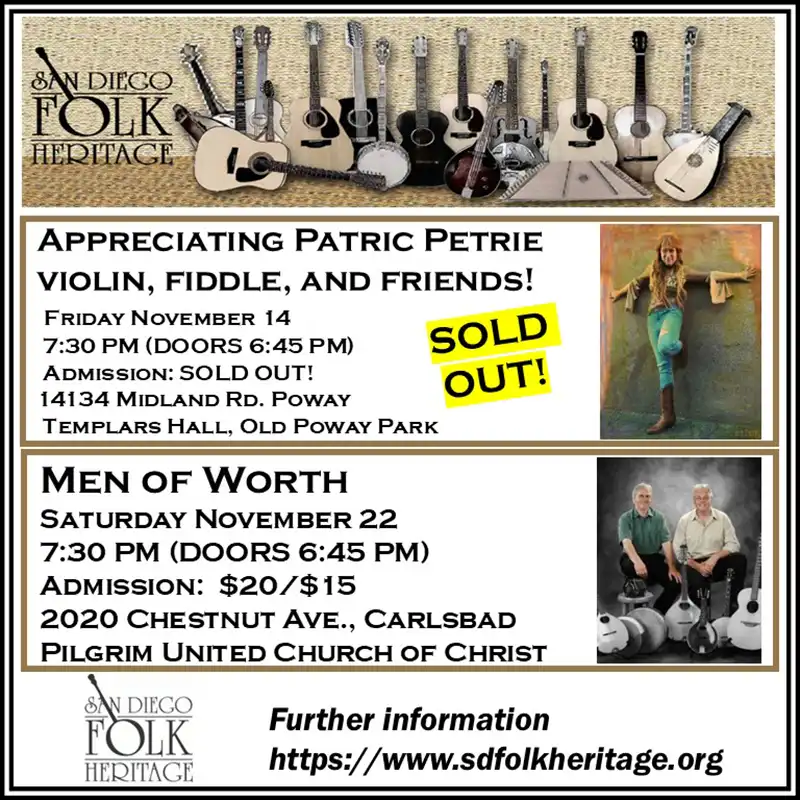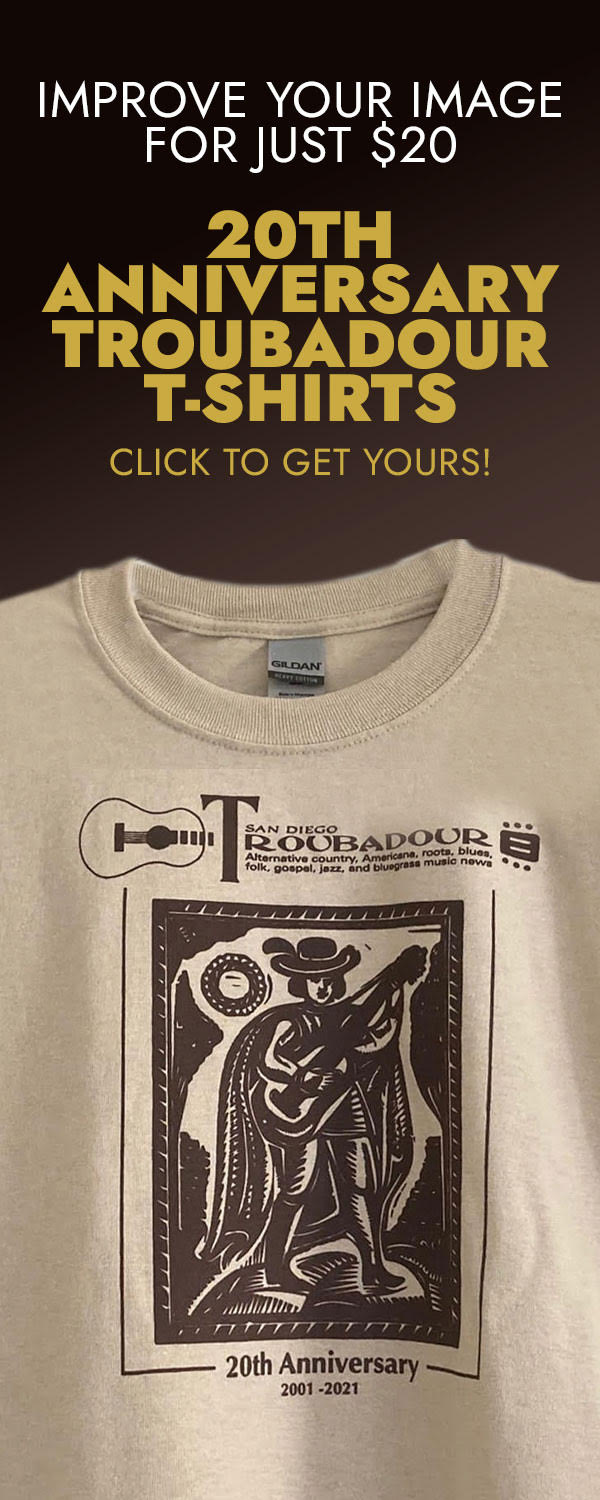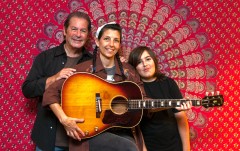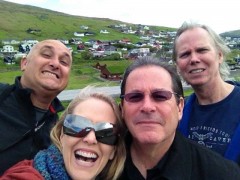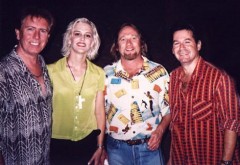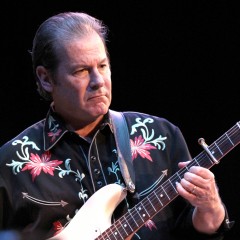Cover Story
Marc “Twang” Intravaia’s Dance with Time, Fate, and People
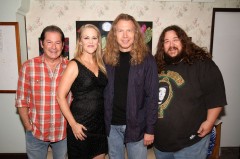
Berkley Hart Selis Twang: Intravaia, Eve Selis, Calman Hart, and Jeff Berkley. Photo by Dennis Andersen.
It was 8 o’clock on Sunday. Like millions of other American households, the TV in the Intravaia household in Kearny Mesa was tuned in to the “Ed Sullivan Show,” as the awkward master of ceremonies took the black-and-white stage to few muffled screams and introduced the Beatles. The four had identical haircuts, neat suits, and to a chorus of screaming teen girls, immediately kicked off with “All My Loving,” saving their big hits for later in the show. Seven-year-old Marc was in his bedroom–it was a school night, but his dad came and rousted him.
“He pulled me out from the bedroom and said, ‘Hey, you’ve got to see this band; I think you’ll like them.’ So me and my sisters ran out, and that was it. We were hooked.” They went to Fed Mart that night and bought Meet the Beatles.
“That night I decided I wanted to be a professional musician.”
Intravaia traces back the dawn of his lengthy career, which has included 25 years as a singer, songwriter, and guitarist for the veteran, influential Eve Selis band; work with the roots quartet Berkley Hart Selis Twang; and earlier projects, including the seminal local pop group Listen. He also marvels at how time, fate, and people sometimes can dance in odd twists and turns. That night in 1964, Lennon played a song that he wrote with Paul McCartney in Jane Asher’s cellar a few months previously, using a Gibson acoustic guitar: “I Want to Hold Your Hand.” That guitar somehow found its way to Marc’s studio, and into his hands, half a century later.
“My friend John McCaw had been bringing that guitar to my amateur group that I teach on Tuesday nights, and I helped uncover the fact that it was John Lennon’s first acoustic, and that he wrote those songs that really changed everything. “She Loves You,” “I Want to Hold Your Hand,” “This Boy,” and “From Me to You” were written on that guitar–and now, it’s the cover of a book.”
His student had bought the J 160E guitar, which disappeared in 1967, in a thrift shop in 1969, unaware how special it was. After some thorough investigation, the guitar was auctioned and sold to an anonymous bidder for $2.41 million in late 2015. In the list of most expensive guitars ever, it places second, ahead of Jimi Hendrix’ Woodstock Stratocaster (purchased by one of the founders of Microsoft), behind only a Strat sold at the Tsunami relief auction autographed by 21 of music’s top performers.
Last summer, Intravaia was able to add another chapter to his Beatles/Lennon guitar saga by playing Lennon’s guitar while recording a version of his classic song “Norwegian Wood” with bandmates Jeff Berkley, Calman Hart, and Eve Selis.
The son of a jazz trumpet player who became a music teacher, Intravaia had plenty of exposure to music growing up–mostly jazz and classical. His took his first guitar lessons at age 11, but his mom wanted him to be a jazz bassist. His experience with the Beatles opened his eyes to pop music, starting a lengthy love affair with their sound.
“When I listen to any particular album it brings me back to that time when I was first listening to it. When I hear Beatles VI, that brings me back to third or fourth grade. Sergeant Pepper’s, sitting in my room, taking it home, and just looking at the cover and listening to it for like three days. Revolver, being up in San Francisco in 1966 with my family and seeing it in a store window. Then buying it and having to wait until I got home to listen to it, about a ten-hour drive–it was like torture. I loved them all, but then as you do when you grow older, all of your influences start changing.”
The new groups and sounds that caught his ears were the blues guitar bands and Crosby, Stills, Nash and Young, who helped bring country into the pop mainstream.
“CSN&Y were huge influences, and I loved them. As a guitar player I loved Steve Stills, but I also loved Taj Mahal and Jesse Ed Davis. When my sisters introduced me to more blues-based stuff, I just glommed onto that, I loved it.
“You know, it’s just all of these different transitions you go through as a young person. But it always came back to blues-influenced guitarists. Then, country came along and I always thought, naw, it was not for me.” That was about to change.
“I would watch Hee Haw because they would always play live and they always had great guitar players on. Then, when I met my wife she introduced me to the music of Steve Earle, Lucinda Williams, and really old country like Hank, Johnny, and George Jones. I loved that–and all of the sudden that became a focus in my life and a passion. It always changes, which is good, because otherwise you get bored with it.”
His favorite memories of Hee Haw, the 1969-71 TV variety series hosted by Buck Owens and Roy Clark, were of Owens and his guitarist, Don Rich, as well as Clark, who was a master on guitar. “I was just ‘Whoa, these guys are no country bumpkins, these guys play their asses off.’”
Intravaia was developing his own skill set as a guitarist and has favorites and styles of guitar playing that he favors. Among his A list are the late Jesse Ed Davis and Mark Knopfler.
“It’s the lyricism and the space. They don’t overplay things, not that there’s anything wrong with that–that’s why there are so many styles of music and everybody loves different things. I always loved melody and tone, the way that they bend the strings. Jesse Ed Davis made me aware of the bridge between blues and country, the way he would bend his strings had a country flavor to them, but it was always steeped in the blues. There is a solo that was huge to me, it just made such an impact on me when I was, like, 14 years old, and that was ‘Bacon Fat.’ When you listen to the way he phrases and bends in his vibrato, it’s just gorgeous. It’s not a flurry of notes, but it speaks volumes. Mark Knopfler does the same thing, where he can just play a few notes and get so much out of them. It’s fun to listen to somebody tear it up, like Albert Lee, and just go all over the place. But emotionally, that is what hits you in the heart, when you hear the melodies come through the lead guitar playing, the phrasing.”
Another guitarist that made a big impression on a young Intravaia–and a whole lot of others–was Jimi Hendrix. He credits his older sisters Leah and Shawn with being important to his musical education, bringing home records by groups he had never heard of ,and taking him to see classic acts like Cream, Janis Joplin, Hendrix, and CSN&Y, whose 1969 Balboa Stadium concert was his favorite show ever. He saw Hendrix play live locally three times, including his Balboa Stadium concert in September 1968, when his guitar playing was remarkable–but his stage antics were low-key.
“I remember feeling a little disappointed because he put in a subpar performance. I actually had to be talked into going [in May 1969], even though I loved his records, into seeing him again at that show at the Sports Arena. I was so glad I did.” Hendrix was electrifying. Intravaia recalls details about that show that reveal, again, another twist and turn of time, fate, and people:
“There was a band called Fat Mattress that opened for Hendrix at that show. I have bits of memory about that show–I was about 13 years old–but what stuck with me was that the bass player wasn’t there for the first 15 minutes of Fat Mattress’ set. I remember thinking that was weird and I can still remember the guy coming out and putting on a bass minutes into the set. That’s really weird, I remember thinking where was that guy, was it a rock ‘n’ roll thing? Was he passed out backstage?
“I’m telling this because a couple of years ago we’re in England, and one of my friends goes, ‘Hey, do you want to meet a guy who sang on the song ‘Fire,’ with Hendrix? I said, sure, so I go over and meet this guy named Jim Leverton, and at the time I didn’t know his background. And so we’re talking and we hit it off, and it turns out he was the bass player in Fat Mattress, which was Noel Redding’s band. He said that they grew up in the same village, and that’s why he got the call to go over to the studio, ‘Hey, we need somebody to sing on this song we’re recording with Jimi Hendrix.’”
After they talked for a while, Leverton revealed he wasn’t paid for the “Fire” gig, then Intravaia mentioned the San Diego concert, and the missing bass player.
“He goes, ‘That was me.’ No passing out backstage or groupie story either. The band took two cars to the Sports Arena and his ran out of petrol. “Mystery solved after 43 or whatever years,” says Intravaia.
Other classic concerts from the period also resonate and would end up being echoed in later connections.
“I saw CSN&Y in ’69 at Balboa Stadium, a great concert, one of their best of that era. And then when we opened for them in ’96, I played a long solo at the end, and the crowd was really with us. I put down my guitar and stepped to leave the stage, and there was Stills and Nash, and they were complimenting me. I was talking to them after that show and I told Stephen that he was a big influence on me. He smiled and said he could hear some of his licks during my solo. That was fun to have a personal connection.”
In a band called Marshmallow Highway, Intravaia got his professional start. By his late teens, he was a member of a very successful local band called Listen. And another twist of time, fate, and people found Intravaia.
He recalls learning the distinctive opening guitar riff to America’s “Ventura Highway” while in Listen at age 16. Fast forward to a gig in the early 2000’s with Gerry Beckley, who is an original member of he band. Hearing him play what were two harmony guitar parts simultaneously, Beckley stopped the song. “’How do you do that?’ I go, ‘I learned it when I was 16; I thought that’s what you did on the record.’ And he goes, ‘No guitar player has ever done that in our band. That’s awesome.’”
Listen appeared on four Homegrown albums recorded by local FM mainstays at KGB. Radio personality, writer, and musician Jim McInnes co-produced all but the first of the series, and a local Homegrown Show a few years later. These featured songs about San Diego, written and played by local artists, with proceeds going to charity.
“Jim has been a friend since ’74. Do you remember this? [plays ‘KGB San Diego’ jingle on guitar] That was me. We were on the Homegrown albums and they said, ‘Hey, do variations of this.’ So we all went in and we played them, but the one that was on the radio the most was just me on the acoustic guitar playing that KGB musical logo. My claim to fame. People will find the Homegrown albums at garage sales and drop them off.”
McInnes played a vital role in promoting local talent during his 28-year career at the station and is now working with another important promoter of local music, Cathryn Beeks, on a new Homegrown project.
San Diego native Intravaia went on to gigs in such local bands as the Heroes and the Monroes [playing on the international release of their hit “What Do All the People Know?”] in the ’80s, then temporarily relocated physically and musically to the LA area. He was back in town to start working with Selis in 1991. He also started to seriously develop as a songwriter, but first, he decided he needed a new identity: Marc Twang.
“That came about because nobody could pronounce my name. Eve and I had been signed to a deal and we had some CDs out, and so seeing other people in town with nicknames–like Dan McLain took Country Dick, and there are a few other friends that we admired who had nicknames, and so my wife says, ‘Why don’t you just call yourself Marc Twang?’ I said okay, that sounds good and didn’t think much of it. Then it turns out that we uncovered a CD by John Hartford recorded in 1975; he’s one of our favorite musicians and songwriters, and he recorded a CD called Mark Twang. So it was all meant to be, kind of a happy accident.” Or maybe another case of time, fate, and people taking an odd turn.
“Eve and I have been working together for 25 years and our band has been with us for over 15 years. Rick Nash plays bass and Larry Grano on drums are an amazing rhythm section. Sharon Whyte, who plays keys and vocals, is in my opinion a musical genius. We all fit together perfectly, and, most important, we don’t fight.”
“I love playing with this band, and I really enjoy playing off of the other guitarist, Jim Soldi. He constantly challenges me as a guitarist, and these past two years we’ve been including harmonica player and Nashville transplant TJ Klay. He’s one of the most lyrical players on the planet and is world class.” Soldi, who is also known as “Cactus”–as was his East County country music legend dad–has played with many of the top national country acts, including Johnny Cash and Ricky Skaggs.
The Intravaia and Selis songwriting team met with considerable success, as Selis and the band have been a frequent presence in the Americana roster of the San Diego Music Awards nominations and winners. They have released eight albums since 2000. Intravaia’s songwriting approach has evolved over the years.
“Writing is certainly something you have to work at. I’ve finally come to terms with it, and it’s just recently, because I’ve always tried to do both–writing lyrics and music–and I can do it. But my ear always goes to chords and melody first, before I’ll hear the words. That’s just how I am. In co-writing sessions with Eve and Jeff [Berkley] my strength is progressions and melody, so there’s some stuff on the new CD that Eve’s coming out with where I wrote the song, and the lyrics kind of got written later. Through conversation and talking with one another, ideas pop up.”
He has also discovered a new partner. “I have written complete songs, without lyrics, without song titles, and I was talking to my wife before New Year’s, saying that I really wish I had a dedicated lyricist to work with. And she goes, ‘Why not me?’ Because she’s a beautiful poet and artist and a voracious reader, loves words, loves wordplay. I’m like, okay. So I sent her some complete songs–music and melody–and we wrote five songs together in the space of about two weeks.”
He’d like to record a CD of songs written by his wife and him, but not to perform.
“I’m not interested in playing the songs out live and being a front person; I’m not interested in that, never have been. Just something to give to friends and family; hey, band, this is what we’re doing. We’ve been having a ball, it’s an eclectic mix of stuff. A story about serendipity and how there was no word for serendipity in the Czech Republic, and yet there was this artist who knew that that feeling existed and had to go research it–this was a long time ago, this old NPR story. And so she wrote a lyric called ‘Serendipity’ and it’s this cool tune. And Calman Hart is just like my wife in that he just loves words and is a storyteller. He is, I think, so brilliant, and so what I love is that I’ll rework music and musical ideas, and I’ll change and alter and perfect as much as I can. I don’t like doing that with lyrics, because it is not my strong point.”
Intravaia co-wrote half a dozen songs and plays on a number of the tracks on the new Eve Selis CD, See Me With Your Heart, which is being put together in Nashville. He and other members are enthusiastic and supportive of her; it’s a chance to bring new ideas and approaches into the mix. The band will tour England later this year to promote the album and have been playing across the pond regularly in recent years.
“We started going there in 2003, just Eve and I, and we ended up signing with a label out of London called Proper Records. We recorded one CD with them, and because of that CD, we caught the ear of Bob Harris, who is a pretty legendary guy over there. He had a show called the ‘Old Grey Whistle Test,’ and everybody was on it. Bob really championed our music; we got played on BBC Two, not a hit record or anything, but we were a presence over there and were able to build a following.”
The plan is to play smaller festivals, theatres, and clubs, targeting venues with 100-300 people.
“It’s not a giant fan base, but it’s a loyal one. I have a sister over there in York, who moved there in ’72, so it’s really great, because I get to see her every year whether we’re playing in York or not. I’ll always make a trip out to spend the day with her and her husband, so it’s fun. It’s good because we can go over there for a couple of weeks, then come home and get back into the routine of teaching and raising our families.”
Stateside, the Selis band has a similar loyal following. As with many bands that have been together for 15 years, they are not a new phenomena, but their music is just as fresh as that of younger Americana acts. A recent added focus is the quartet of Berkley Hart Selis Twang, which joins two members, each from two of the top roots bands in San Diego. BHST released an eponymous album last year. Twang also is involved with Back to the Garden, which is primarily a cover band of Crosby, Stills & Nash songs.
“When we have the foursome group–Berkley Hart Selis Twang–I do see some younger people that come to that, because I think Jeff Berkley, in particular, is out there all the time, playing. He’ll play to more of a younger crowd, so that helps us get exposed to younger people.
“Back to the Garden is basically the Eve Selis Band minus Eve; we’ve all been playing together for 15-plus years. It’s a covers band, but we seem to have tapped into the tribute show market, because we love the harmonies of CSN&Y.” A CSN&Y tribute show has been scheduled for March 26, at Twang’s Sanctuary Art and Music Studio in Sorrento Valley (go here for details and ticket information: http://jphc.simpletix.com/ EventDetails/25723/ Time/56442/#.VszA1CnJr-l). They have also played a Woodstock show and a “Last Waltz” gig with Berkley Hart.
Among the upcoming CDs and tours are a 25th anniversary concert for him and Selis, supported by the band. Date and location TBA (check Selis’ website). He and Selis will also be appearing April 9 in Berkley Hart’s “O Berkley Where Hart Thou?” show as guests, at the Poway Center for the Performing Arts. A show to celebrate the release of Selis’ solo disc will happen before the band leaves for England in early July. Back to the Garden is busy also, set for a tribute to CSN&Y on March 26 at Intravaia’s Sanctuary Art and Music Studio in Sorrento Valley, then performing the “Music of Laurel Canyon” this fall (Oct 8) at the Poway Arts Center as the core band with guests.
Recorded music is also forthcoming. “The Eve Selis CD is going to be released this spring. I’m going to record a solo CD, written by myself and my wife, Paula, which we hope to have coming out by the fall. Back to the Garden is going to record a CD of covers and originals that will support the Laurel Canyon show, so it will be mainly covers of music from that era–CSN&Y, Jackson Browne stuff. So we have three different things coming out–you know, staying busy.”
Besides writing and performing music, Intravaia is a music teacher and, with his wife, operates Sanctuary Art and Music Studio in Sorrento Valley. His modest studio is decorated with photos–like one with CSN&Y members. He isn’t really a gearhead, though. He favors Uber boutique amps built by local Tony Huber. The guitars are, for the most part, workmanlike Fenders and Gibsons, his one nod to Lennon being an Epiphone Casino. “I use them; I play them all. They’re not just there because that one looks pretty.”
“I’m going to be 60 in September, and I feel very creative and love writing, but my attitude has changed greatly regarding what I hope comes of it. I don’t–and I don’t mean this to sound apathetic, because it is not out of apathy–I don’t have any agenda. I don’t have any expectation for ‘If I write these songs, and record this CD, I hope that it gets in the hands of hotshot producer Phil or that it gets picked up for television.’ I don’t care about any of that. I have a good business here. I love teaching, I love playing live when I can, but I just love the process and the challenge of continuing to create and express ideas and thoughts, and play guitar. Without any expectation for what it might get me, I just need to get it out of my head, so I can move on to new thoughts and ideas.
“That’s what happens when you get older, your goals and your ambitions change, but that doesn’t mean your creative spirit is lessened. It’s what you need to do. I need to play guitar, I need to write songs. I don’t have to, I like to, it’s there. My wife Paula needs to write. We have good decent careers, but it’s what keeps me connected to everything, to my friends, to the world.”
A world where time, fate, and people, as Intravaia knows well, can sometimes dance in odd twists and turns. Starting his quest at age seven, when his musician father turned him onto the revolution that was the Beatles, he closed that circle in 2012. He and Selis were playing at Abbey Road Recording Studios in London, at the invitation of Harris, in studio two–the Holy Grail of pop music in the eyes of many, where the Beatles recorded most of their albums. And a fitting place for a final tribute.
“We smuggled our dads’ ashes–just a little bit–and sprinkled them in the garden at Abbey Road Studios. That was my way of saying thanks to my dad.”




